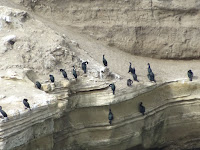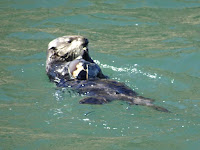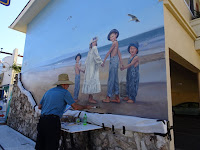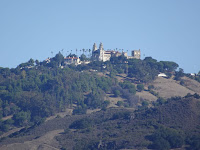

A slow and easy sail - occasionally stopping to clear kelp from rudders
We left a few minutes after sunrise for what we knew would be a slow 25 mile sail to our next anchorage at Prisoners Harbor on Santa Cruz island. The wind was hardly there, but the islands had effectively blocked the swell. This allowed the sails to maintain their curved airfoil shape without constantly filling and collapsing, which allowed us to move at a nice, peaceful crawl on a beautiful, clear day. We stayed in the warmth of the cockpit enclosure reading to each other while enjoying the gradually changing view of Santa Cruz's cliffs as we slid by.
When we finally reached Prisoners Harbor, we found another boat in our intended spot to the wast of the pier, so we found good holding to the east. Our all-day crawl left just enough time to watch the sun set behind the hills and prepare for the next day before darkness fell.


Sea Lions hang out on their backs all day
and we relax along with them (from the boat)
Santa Cruz - day WOW!
We both had a night of weird dreams that kept us up half the night. I kept thinking we were in the boatyard with a million things to attend to. Maryanne dreamt I was in a bad motorcycle accident. When the first light of morning started coming through the hatch, it was way more appealing to stay in bed than to get moving, as I had originally intended. No worries, we had a short day planned, so it getting up late wasn't a huge deal.
We were underway respectably before noon.
The wind was still nearly nothing, but we were only going eleven miles to the eastern end of the island.
We were transitioning from motor to sail when we spotted what looked like a tide rip ahead. It could have also been where the wind started creating ripples in the flat sea.

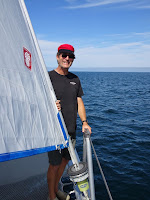
Fist Dolphin Visit of the day brings a crowd playing at our bows
We unfurled the sails and started slowing the engines in preparation for shutting them down. Just then, I saw three dolphins coming over to play in our bow wave. Oh, we love dolphins. They always seem to stop whatever they are doing to come over and play. We ran to the bow and that's when it hit us. The churned up water way ahead that we thought was a tide rip was actually the turbulence of HUNDREDS of dolphins stretching over a mile!
Maryanne (the marine biologist, remember) thinks one group were probably herding fish into shallower water by the beach at Prisoners in order to make them easier to catch (but admits that is a guess). Eventually they all seemed to leave what they were doing and pass right by us.


..And then the larger crowd joins us and put on quite a show in all directions
It was incredible! We were completely surrounded by hundreds of them. I have never even come close to seeing that many dolphins in one place in my whole life at sea. We had just sailed through the North Pacific Annual Dolphin Conference and they had all joined in as our escorts!
We still had almost no wind, but the noise bad turbulence they made made it sound like we were hearing surf landing at the beach. It was L.A. Traffic of dolphins!
Wow!
We were too slow for them, so they eventually went on their way. The wind picked up and we had a nice, fast sail to our next anchorage at Smuggler's Cove. Smuggler's is beautiful - surrounded by high, yellow hills that turn orange in the late day light.

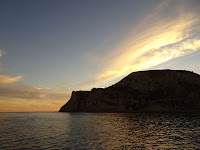

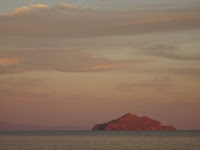




Safely arrived at Smugglers Cove
Some time to relax and enjoy the calm before we wait out the storm
Perfect days of sailing like this are rare and beautiful. We slog through all of the miserable times for a day like this.
We spent a whole day at Smugglers, where we enjoyed Bald Eagles and beautiful views. The last forecast we had been able to pick up called for high winds and rain all day, so our plan was to hunker down behind the hills and have an indoor day reading and cooking comfort food.
It didn't turn out to be so bad. The clouds held off until afternoon, making for a perfect climate inside the cockpit enclosure. Instead of an indoor day, we spent our time pottering around doing minor maintenance and tidying up.
We were just starting to think about donning our wetsuits and going for a swim when the clouds moved in and it started sprinkling. That effectively killed our motivation for that. Back to plan A.
It wasn't until 1 a.m. that the weather arrived. I had set our anchor alarm with a small radius so I would know if were starting to swing in a different direction than we had laid out our chain. It woke us by screaming at us. (Literally. The alarm noise is of a screaming chimpanzee). We resisted the strong temptation to spring out of bed, but instead checked the display to see if we were swinging or if we were really dragging and which way. The distance to our set point increased for a bit and then decreased again. Whew! Swinging.
We were almost asleep again when the screaming started again. This time, we could hear the wind picking up and feel Begonia yawing around when she came to the end of her rode and the bridle turned her to face the anchor. Perhaps I'd better get up this time and have a look.
I turned on the wind instruments. The wind was about 15 knots, gusting to 24 or so - not too bad. I went outside in the rain to see what I could see. At the bows, even though it was really dark, I could clearly see the vee of our bridle going from each bow to where it met our anchor chain in their middle. From there, I could see the first half of our chain as it receded away toward the anchor. All of this was because brilliant bioluminescence lit everything up as if we had strung glow sticks the whole length of our rode. All of the breaking crests of the little wavelets around were also lit up. We seemed to be holding fine, so I went back inside.
Since we had no cell service with which to pick up a detailed forecast or get a good look at a radar picture, I tuned in NOAA weather radio on the VHF just to see if anything new had cropped up since the last time we had been able to check the weather two days ago.
As I figured, the forecast was over a much to broad area to be of any use to us. It basically said, "Entire Pacific Ocean: winds of variable strength and speed, changing to winds of other strength and speed..." Okay. The only helpful information was the buoy reports, which said the waves were higher to the west, from where the storm was approaching.
We had a few flashes of lightning, the rain picked up for a while and then began to decrease. The pull on the chain lessened and its weight pulled it toward the sea floor and Begonia back toward the anchor.
Leftover swell woke us again just before sunrise. Begonia pitched and rolled in at least two difference wave trains. Oh, well. We had to be up to start our next leg anyway.


